Food Index

Women are often very concerned about potentially eating something that could harm their baby and various sources of information are often inconsistent. This confusion is stressful and can cause women significant anxiety, especially if they research a food after they have already eaten it.
First, most guidelines regarding specific foods during pregnancy are based on what is known about the spread of foodborne pathogens, chemicals, or heavy metals, rather than a specific food itself.
To date, while there is a possibility that a specific food may contain properties harmful to fetal development (as opposed to a bacterium or other contaminant), none have been identified. However, additional research is necessary to determine unanswered questions regarding unripe papaya and certain herbs.
Further, while certain foods may carry higher risks of pathogens than others, women can consume almost any food they enjoyed prior to pregnancy with just a few exceptions and specific considerations.
Women who have any questions regarding their diet during pregnancy or the safety of specific foods should talk to their health care provider (HCP). Women should also consider reading Safe Food Handling for additional information regarding the safe purchase, preparation, cooking, and storage of food.
Background
Whether a food is safe to consume during pregnancy mostly relies on that food's ability to harbor a harmful pathogen rather than the food itself. However, with proper food handling, storage, and cooking, most of the risk associated with certain foods (poultry, beef, eggs) can be mitigated (salmonella, E. coli, listeria).
Confusion occurs when women want to eat foods that are not always cooked or reheated, such as cheese and other dairy products, deli meat, sushi, and fruits and vegetables, or foods in which the harmful agent (mercury) remains even after cooking (seafood).
While not all risk can be eliminated from the above, if women take into account certain considerations, they can reduce their risk as much as possible, making their overall risk of consuming something harmful extremely low.
For additional background:
Salmonella: Salmonellosis is an infection caused by Salmonella bacteria; it is a kind of food poisoning caused by eating contaminated or improperly cooked food, most often from poultry and eggs. It can also occur through contact with live poultry. Although rare, severe salmonella infection has been documented to cross the placenta and infect the fetus (read more).
E. coli: Escherichia coli are a large group of bacteria found in the environment, foods, and intestines of people and animals. There are many strains, most of which do not make individuals sick. However, other strains of E. coli can cause three different types of illnesses: gastrointestinal, urinary tract infections, and neonatal meningitis. E. coli is also commonly associated with undercooked beef. (read more).
Listeria: Listeriosis is a rare foodborne illness caused by the bacterium Listeria monocytogenes, commonly found in soil, vegetation, and animal feces. Listeria is known to disproportionately affect immunocompromised patients, elderly people, pregnant women, and newborns. Although rare, the consequences of invasive infection in a pregnant woman can result in neonatal complications, with a high mortality rate (read more).
Meat
Meat (poultry, veal, pork, ham, beef, steak) is safe to eat during pregnancy when properly purchased, stored, handled, and cooked (and steak/hamburger ideally well-done to further eliminate risk).
Proper cooking/baking temperatures:
Poultry (including whole and parts of chicken and turkey): 165º F
Ground turkey and chicken: 165º F
Beef, veal, lamb steaks and roasts: 145º F then let rest for 3 minutes (previously recommended at 160º F)
Pork chops, ribs, and roasts: 145º F then let rest for 3 minutes
Ground beef, pork, veal, and lamb: 160º F
Hot dogs, luncheon meats, and deli meats: reheated to steaming hot or 165º F
Reheat fully cooked hams packaged at a USDA-inspected plant to 140º F; any other location or for leftover fully cooked ham, heat to 165º F
“Deli meats” refers to cooked meats that have been sliced and prepared for sandwich, wraps, etc. and are also called sandwich meat, lunch meat, cold cuts, or sliced meats. The FDA estimates 1 case of listeriosis in 83,000 servings of deli meat consumed by pregnant women. Risk is eliminated when processed meats are cooked/heated to steaming prior to consumption.
Hot dogs are safe to eat during pregnancy; however, they should never be eaten straight out of the package, or “warmed up” – even if the package indicates they are full cooked; hot dogs should be heated until steaming hot prior to consumption.
Bacon is safe to consume during pregnancy – but it needs to be fully cooked, the same with any other meat.
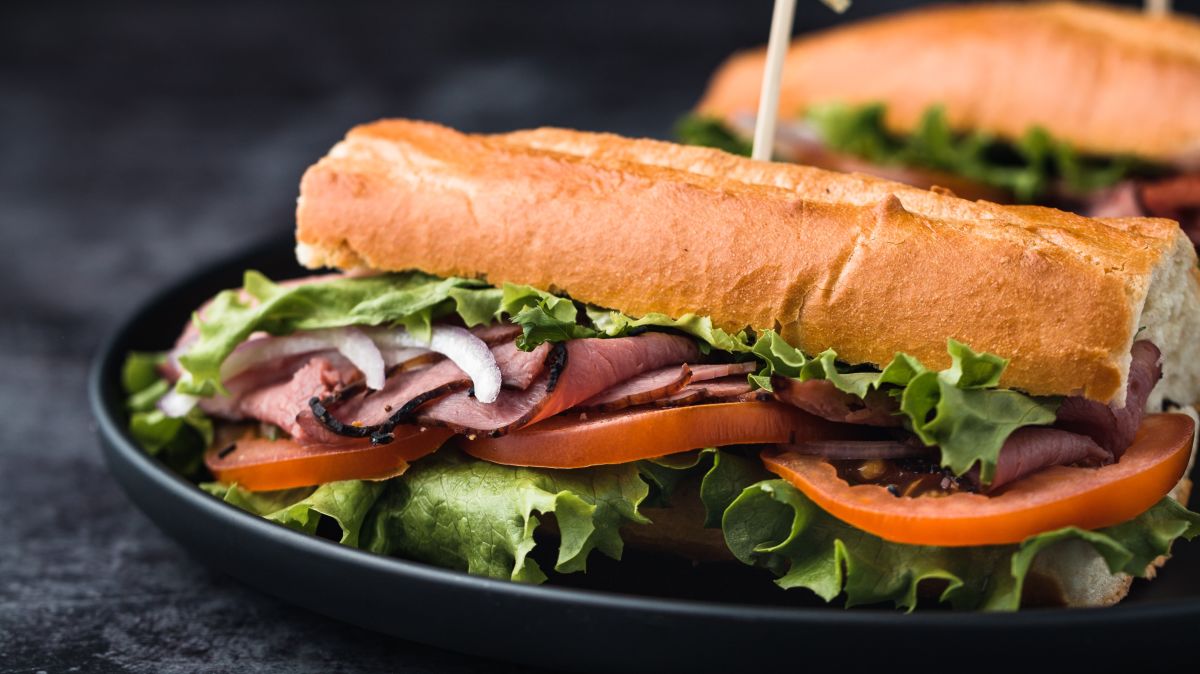
Dairy
“Rules” regarding the safety of different types of dairy products during pregnancy can be frustrating, due to inconsistency and a lack of clarity among differing sources of information.
First, most dairy-associated outbreaks of foodborne illness are due to:
Inadequate pasteurization (risk eliminated by choosing pasteurized products)
Unpasteurized dairy products (risk eliminated by choosing pasteurized products) or
Contamination post-pasteurization (risk minimized by avoiding/limiting foods with a higher risk of post-pasteurization contamination)
To prevent infection from inadequate pasteurization or unpasteurized dairy products, women are advised to avoid all raw, unpasteurized dairy products (and juices) as these products carry the highest risk (this includes raw and unpasteurized milks, creams, and cheeses).
Regarding contamination post-pasteurization, it gets a bit more nuanced, as dairy facilities are more likely to be contaminated with listeria than other facilities that process vegetables or other non-dairy products.
Further, certain dairy products are considered higher risk than others for this type of contamination. The most common dairy product associated with post-pasteurization contamination is queso-style (queso fresco, queso blanco) or “soft-ripened” cheeses.
“Soft-ripened” is a category of a cheese based on its rind, texture, and style of ripening, which is usually “outside in”, starting from the rind. Commonly consumed cheeses in this category include Brie and Camembert.
All soft-ripened cheeses made in the United States are pasteurized. Therefore, any contamination from this category occurs after pasteurization. Although pasteurized soft-ripened cheeses are implicated more often than other dairy products in outbreaks, risk still remains extremely low.
Pasteurized cheeses that are not Hispanic-style queso cheeses can be safely eaten (again, contamination could occur post-manufacturing, but this risk could be considered negligible).
Pasteurized feta, parmesan, cheddar, mozzarella, provolone, gouda, swiss, blue-veined, cream cheese, ricotta, and cottage cheese are safe to eat during pregnancy (must look for “pasteurized”). Although rarely implicated in listeria infection (but have been), it still possible after the manufacturing process, similar to any other food product. But again, risk is considered negligible – especially when placed in a cooked dish.

Soft serve ice-cream is safe during pregnancy. However, similar to post-pasteurization contamination at a processing facility, soft-serve ice cream can become contaminated due to the machinery not being cleaned adequately, rather than anything wrong with the ice cream itself.
New models of machinery self-pasteurize, meaning that each night, the machine heats up to a temperature hot enough to kill bacteria that may be present in the holding tank. However, pregnant women are generally not aware of the type of machinery used at a given location.
Regardless, risk associated with tub or soft-serve ice cream is extremely low, similar to any post-pasteurization contamination.
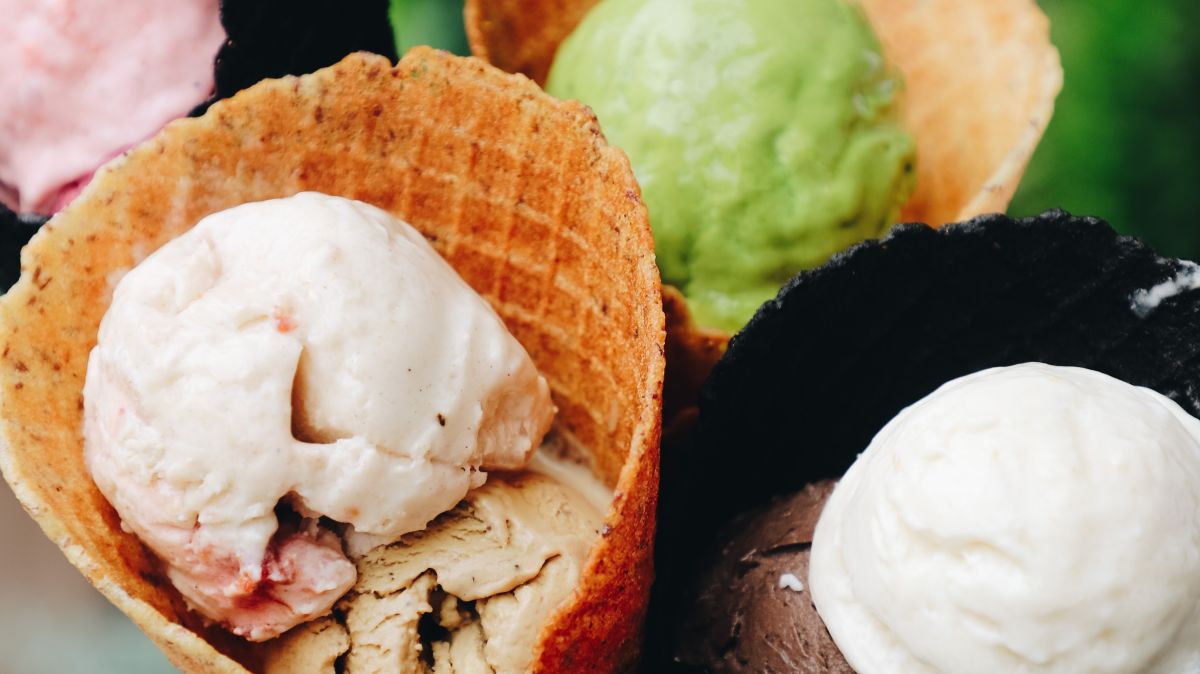
In summary: While contaminated pasteurized dairy is becoming a more common occurrence in the U.S. (better tracking), it is neither feasible nor statistically necessary to avoid pasteurized dairy during pregnancy. Therefore, the recommendation stands to avoid the “riskiest” aspect of this category (Hispanic queso-style cheese; “soft-ripened”), even though overall risk is still considered extremely low.
Seafood
Seafood can be a valuable source of nutrition during pregnancy; therefore, pregnant women should not avoid seafood during pregnancy. Women are simply advised to understand certain considerations and to take cautionary steps to avoid a potential accumulation of mercury in the body.
To avoid this possibility, it is recommended women limit their seafood intake to two to three servings/twelve ounces total per week, of different combination seafood sources that are considered to have low mercury content.
Tuna: Guidelines regarding the consumption of tuna during pregnancy significantly conflict. Some sources indicate fresh tuna should be avoided, some say different types of tuna are allowed in different amounts, and others say all types of tuna are safe, either canned or fresh.
Despite this, there is a large consensus that canned light tuna can be safely eaten up to four-medium sized cans per week, even if other fish are eaten in the same week. Note: canned Albacore tuna has a slightly higher mercury content than white tuna.
Fresh tuna appears to be the only tuna form that has rather consistent restrictions, and is recommended no more than twice per week, with no other fish eaten that week (unless its canned white tuna).
Salmon: Salmon is safe during pregnancy as it is relatively low in mercury, especially Great Lakes and Canadian-sourced salmon. In general, farmed salmon may contain less mercury that wild salmon, but this can also be quite variable. Therefore, cooked salmon can be safely eaten during pregnancy, following the same weekly limits as other seafood (two to three servings per week).
Shrimp is low in mercury content and is safe to eat during pregnancy (cooked).
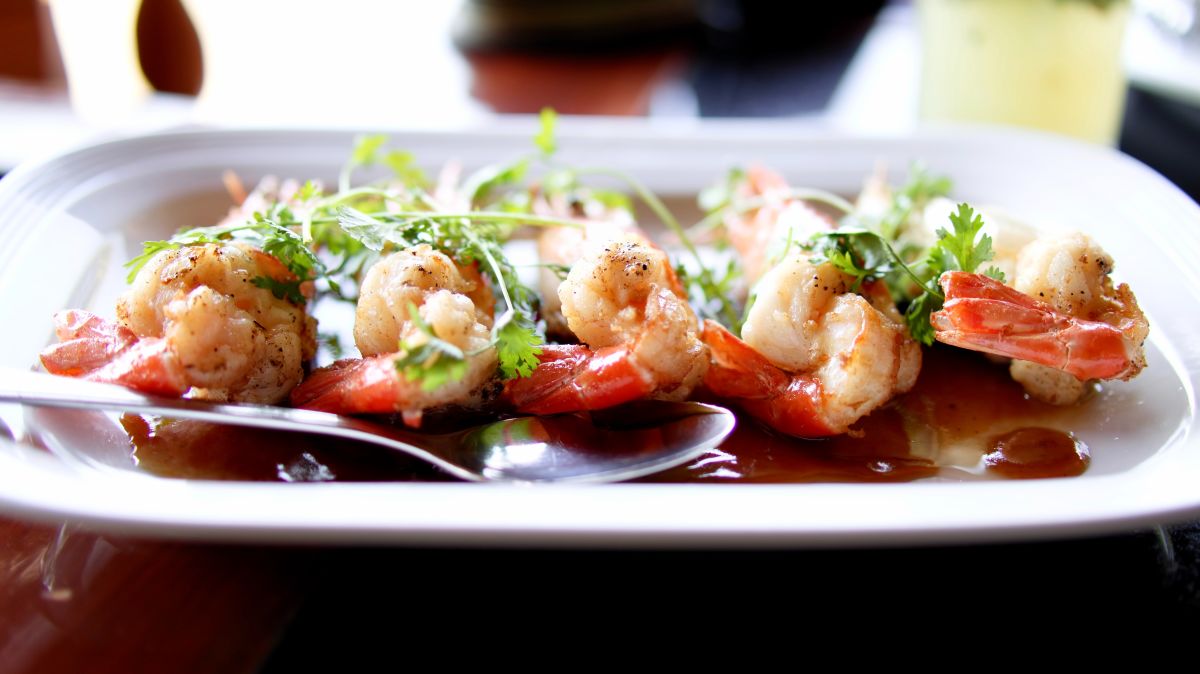
Crustacea (prawns, lobster and crabs) and mollusks (oysters and calamari) are not a concern because they generally contain lower levels of mercury and tend to be consumed less often than finfish.
Best choices of seafood that can be eaten in combination up to two to three times a week:
Anchovy
Atlantic croaker
Atlantic mackerel
Black sea bass
Butterfish
Catfish
Clam
Cod
Crab
Crawfish
Flounder
Fish sticks
Haddock
Herring
American lobster
Mullet
Mackerel
Perch
Pollock
Salmon
Scallop
Shrimp
Squid
Snapper
Tilapia
Trout
Canned light tuna
Whitefish
Halibut and mahi mahi are recommended once per week.
Nova-style, lox, kippered, smoked, or jerky refrigerated uncooked smoked seafood should be avoided due to listeria concerns.
However, canned (i.e. white tuna) or shelf-stable smoked seafood may be eaten (i.e. does not need to be refrigerated).
Additionally, avoiding raw fish is the only way to eliminate risk of foodborne illness during pregnancy. Although freezing raw fish will eliminate parasites, raw fish still carries the risk of bacteria.
In general, pregnant women in the United States should also avoid (due to higher mercury content):
Shark
Ray
Swordfish
Barramundi
Gemfish
Marlin
Orange roughy
Ling
Southern bluefin tuna
King Mackerel
Tile Fish
Sea Bass
Largemouth Bass
White Croaker
Marline Pike Walleye
Eggs
Pregnant women and their babies can benefit from egg consumption just three times a week, which is unlikely to cause any negative health concerns.
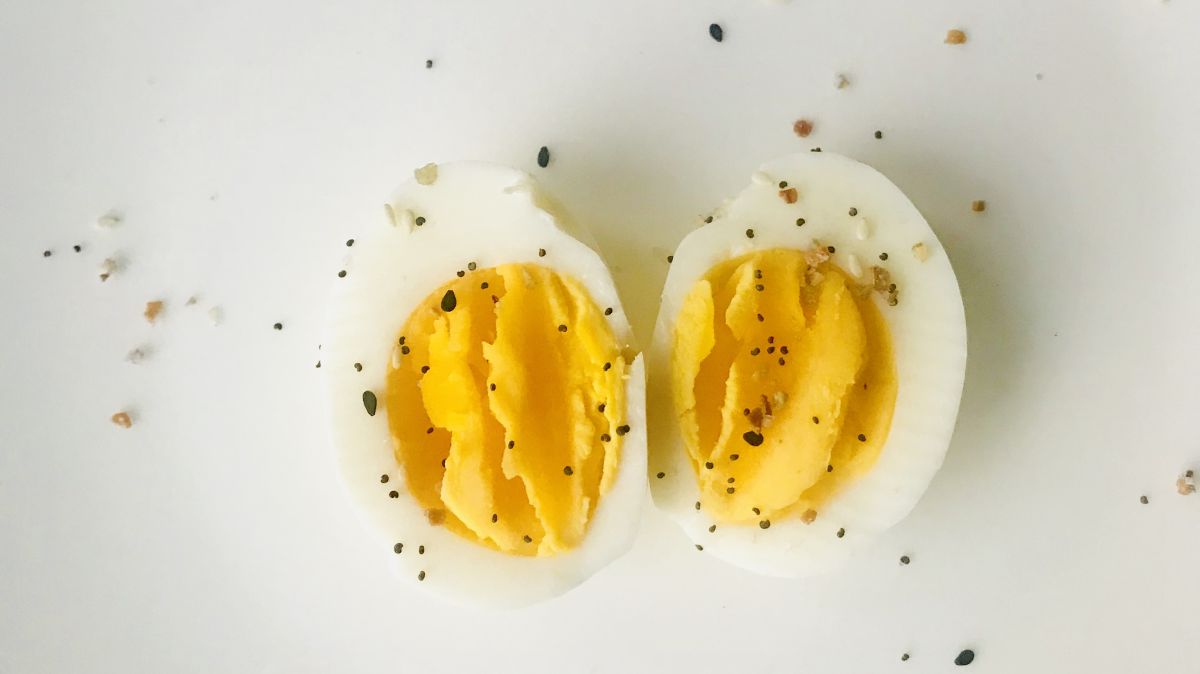
It is important to handle eggs safely and avoid consuming raw, unpasteurized egg in batters, doughs, icings, and other food items due to the risk of food-borne illness. There are pasteurized eggs and egg products that are safe to consume “raw” in certain recipes.
Read more detailed information regarding egg consumption and safe handling during pregnancy.
Fruits and Vegetables
All fruits and vegetables must be “washed” (cold water/no soap) prior to consumption.
Grapes: Grapes (resveratrol, also present in cranberries and peanuts), and their potential harm during pregnancy is currently not backed by evidence and are currently considered safe to eat. Further, some studies have found beneficial effects during pregnancy, even with supplemental resveratrol in pregnancy.
However, more clinical studies with larger sample sizes are needed, as some animal studies have shown (pancreatic/islet cell) harm with supplemental resveratrol. Grapes have much lower levels of resveratrol than supplements; it is estimated a cup of grapes contains less than a milligram of resveratrol, while a typical resveratrol supplement pill contains 250 to 500 milligrams.

Raw Sprouts: Sprouts are common harborers of bacteria, even after rinsing – more so than any other produce item. Whether home-grown or purchased, sprouts need warm and humid conditions to grow, ideal conditions for bacteria (listeria, salmonella, E. coli).
Bacteria easily gets into the seeds used to produce the sprouts; even if just a few harmful bacteria are present, the bacteria can grow to high levels during sprouting, even when grown at home. These bacteria can only be eliminated through cooking, not rinsing – as opposed to other types of produce.
Pregnant women are advised to avoid all raw sprouts during pregnancy, and make sure that when dining out, raw sprouts are not added to salads, sandwiches, or other bowl-type dishes.
Pineapple: Research has not shown pineapple juice to induce contractions when consumed in either fruit or juice form and is safe during pregnancy.
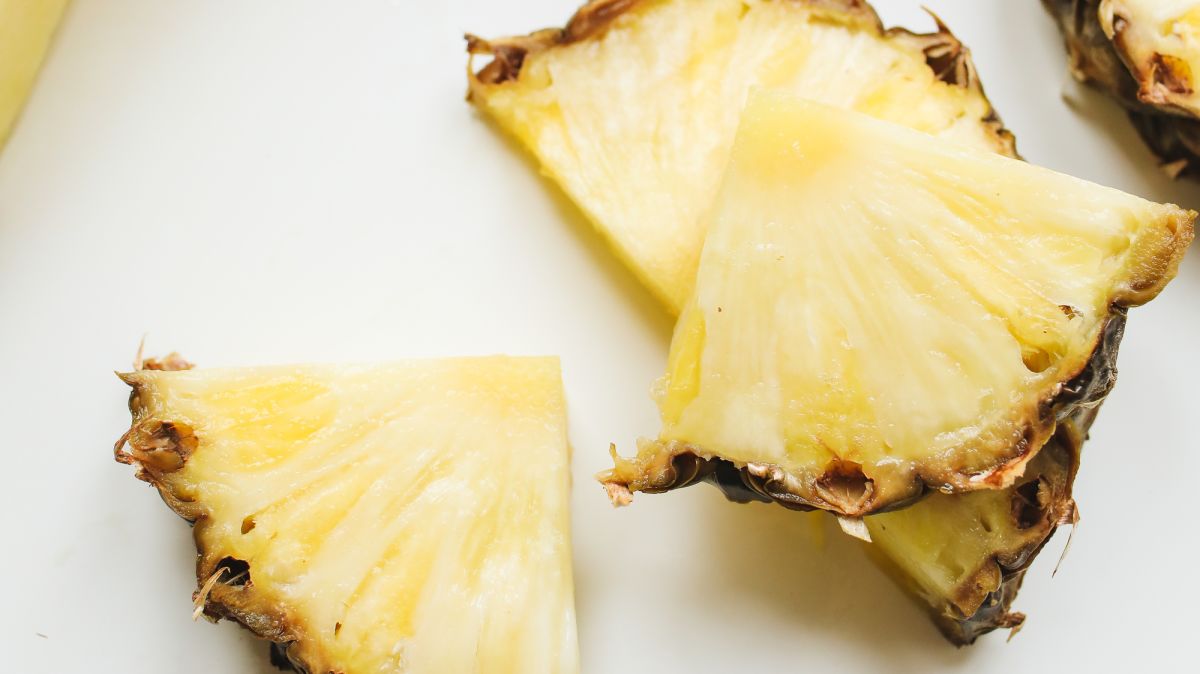
Pineapple initially caused concern after research was published indicating the juice can cause a reaction that induces contractions when directly applied to uterine tissue from rats and humans.
However, a separate study indicated these effects were not seen in the studied rats who were orally (drinking) the juice, and that the enzyme necessary to induce contractions is metabolized through digestion, and therefore deactivated when eaten.
Papaya: Unripe papaya contains enzymes in its crude latex (papain, chymopapain) that can cause contractions when applied intravaginally, and it is theorized that eating a large quantity of it could cause miscarriage. In India and parts of southeast Asia and Indonesia, consumption of unripe papaya fruit is widely believed to cause pregnancy loss, and women are strictly forbidden from eating it.
History: In the 1940s and 1950s, papain was used (but not widely) as an agent to help clear out (irrigate) cervical mucus in women with thick discharge and before cervical procedures. Following this irrigation, which may have also included papain and bromelain (both are digestive enzymes), some physicians noticed that "gross cervical dilatation, enlargement, and transient uterine evacuation were observed in some patients". Further observations showed that intravaginal administration of papain could induce uterine contractions .
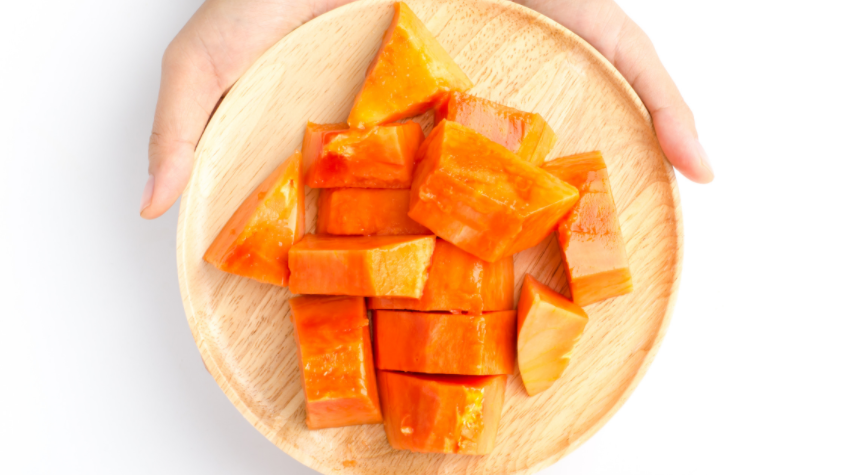
Although adverse findings have also been shown in decades-old animal studies, it is not known if these results (intravaginal) could be extrapolated to humans if the papaya was eaten (similar to pineapple). There are currently no published studies in humans regarding oral unripe papaya and miscarriage or other adverse outcomes of pregnancy.
In 1977, the U.S. Food and Drug Administration indicated: "Papain was found to display no teratogenicity to the developing chicken embryo. Doses used were 10 to 200 mg/kg injected in the air cell or yolk of unincubated eggs." Further, "the oral administration of up to 1,080 mg/kg to pregnant mice (day 6 through day 15 of gestation)...had no clearly discernible effect...on maternal or fetal survival".
A study published in 1995 also administered papain orally to rats. This study did not find any adverse outcomes:
"In two independent experiments, a well-defined and standardized papain was administered orally to...rats in doses up to 800 mg/kg during blastogenesis (days 0 to 6 of gestation, study 2) or embryogenesis (days 6 to 15 of gestation, study 1)." There were no findings of implantation loss or fetal loss in the papain treated group.
"The results of the present investigations lead to the clear conclusion that oral administration of papain up to a dose of 800 mg/kg does not adversely affect prenatal development and does not cause signs of maternal toxicity."
A 2002 study that fed female rats aqueous extract of Carica papaya (Linn) seeds found the following: "Oral doses of 100 and 800 mg/kg body weight were administered once a day on days 1-10 post-coitum...clear conclusion that low dose aqueous crude extract of Carica papaya (Linn) seeds does not adversely affect prenatal development" [but a high dosage could, as] "carica papaya toxicity can adversely affect the fetus". At least one other study in Zebrafish found toxic fetal effects with papaya seed extract.
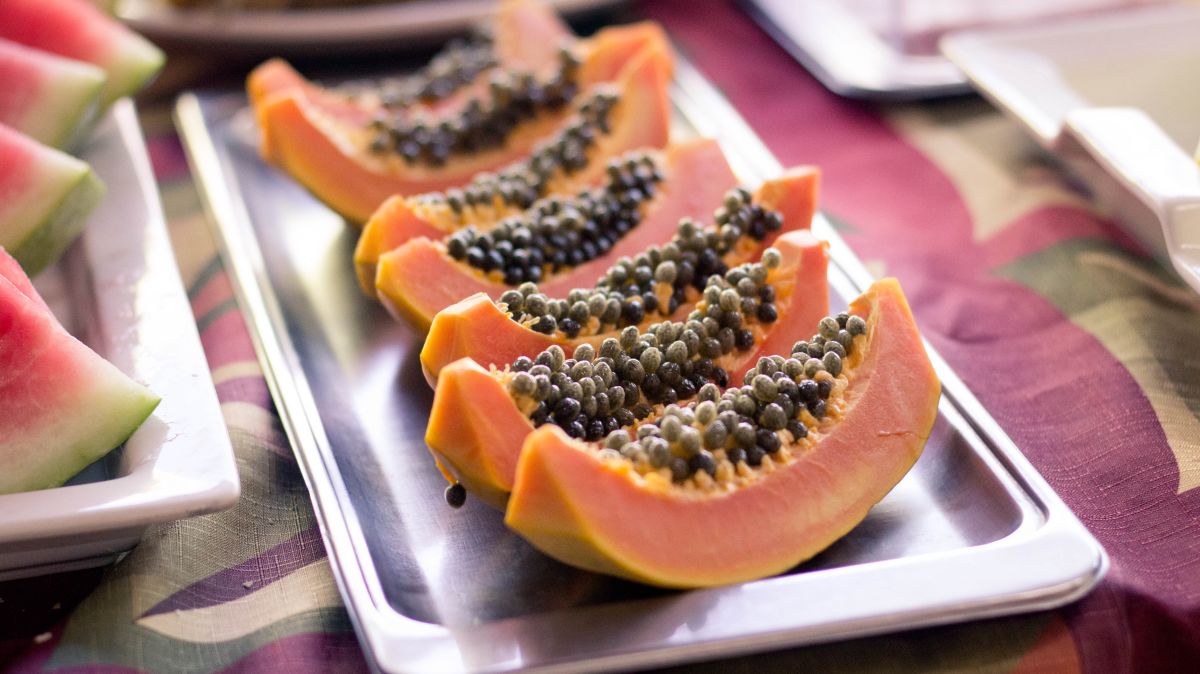
The good news: papain is present in the fruit prior to ripening, but not present in the fruit after ripening. Further,
A separate 2002 study from above indicated: "There was no significant difference in the number of implantation sites and viable fetuses in the rats given ripe papaya relative to the control...ripe papaya juice (0.1-0.8 ml) did not show any significant contractile effect on uterine smooth muscles isolated from pregnant and non-pregnant rats" (but crude papaya latex did have contractile effects).
"The results of the present study suggest that normal consumption of ripe papaya during pregnancy may not pose any significant danger. However, the unripe or semi-ripe papaya (which contains high concentration of the latex that produces marked uterine contractions) could be unsafe in pregnancy."
Papaya starts to ripen as the skin turns from green to yellow. If women wish to eat papaya during pregnancy, they should wait until the papaya is considered absolutely ripe, or they can avoid the fruit all together until more research is completed.
NOTE: Women should avoid papain supplements while pregnant.
Baked Goods
Flour: Flour is a raw food product that has not been specifically treated to kill germs. Therefore, any raw flour, whether consumed in raw cookie dough/batter is considered unsafe (too risky) during pregnancy. Further, raw flour has been implicated in several salmonella and E. coli outbreaks in recent years. Note: Bacteria present in flour is killed when cooked/baked.
Therefore, in general, raw batter or dough for cookies, cakes, cupcakes, pastries, or crusts should never be tasted or eaten during pregnancy. Bacteria could contaminate either the flour or any raw egg used in the dough/batter.
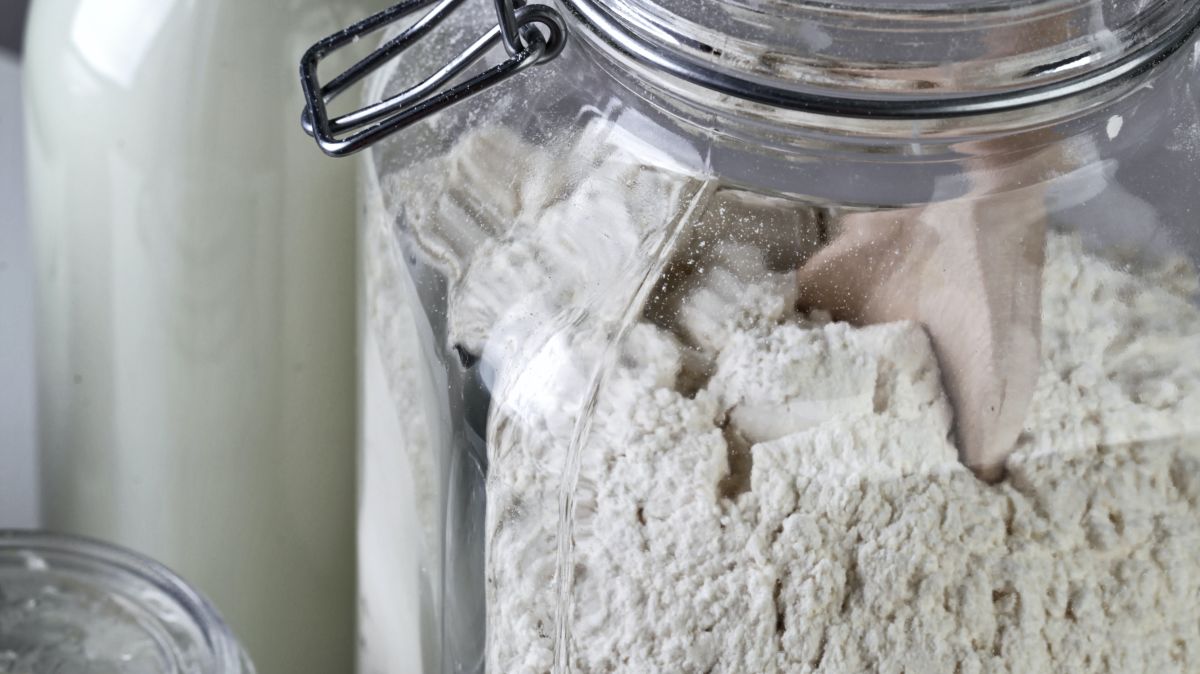
Cheesecake: There are two items to consider when assessing whether a particular cheesecake is safe during pregnancy: whether the cheese used was pasteurized and whether the recipe contains raw eggs (eggs were included in the recipe which was only “set” and not baked). If women wish to eat cheesecake while dining out, they should ask their server to determine these two aspects of the recipe.
Crème Brûlée: Most recipes for crème brûlée require the mixture to be baked in order to set; however, it still needs to be baked properly, to at least 160° F.
Women should always ask their server (or event host) if any dessert contains raw egg or egg white. This may include some lava cakes, mousses, and frostings.
Ready-to-Eat
Ready-to-eat foods (meats, pastas, salads, and pre-cut produce) are considered high-risk sources of potential listeria infection and have been implicated in several outbreaks.
Ready-to-eat foods usually contain high salt and remain refrigerated until eaten – neither of which inhibit listeria growth. Unless a pregnant woman heats these products up until steaming, there is always a very small amount of risk present (in comparison to other foods).
Condiments
Honey: Honey is safe during pregnancy; further, there is no evidence an infant was born ill as a result of the mother consuming honey while pregnant.
Botulism is a disease caused by neurotoxins produced by the Clostridium botulinum bacterium that can cause serious illness. This illness can be caused due to the consumption of honey by infants under the age of 12 months. Children (and adults) over this age can safely eat honey as their gastrointestinal tracts have matured.
Individuals with certain gastrointestinal disorders may be more susceptible. However, based on the molecular weight of the botulism toxin, even if a mother were to contract the disease, it is not believed to be able to cross the placenta and infect a fetus (also illustrated through at least one case report). Therefore, it is currently assessed that women without gastrointestinal illnesses during pregnancy do not need to avoid honey during pregnancy.
Pregnant women with gastrointestinal disorders who have questions regarding consumption of honey should talk to their HCP.
Additionally, women need to make sure their honey is pasteurized (read label).
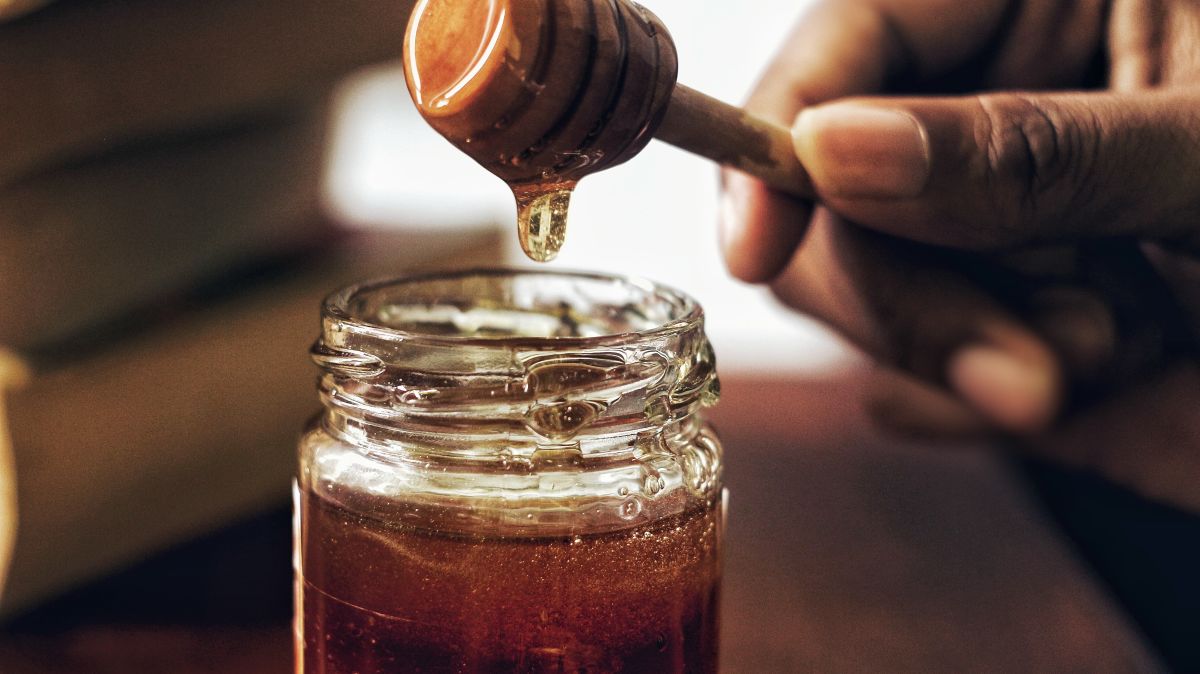
Mayonnaise: Commercialized mayonnaise (at grocery stores) in the United States use pasteurized egg product in their mayonnaise products. However, the traditional way to make the product homemade is to use raw egg.
Women should ask their server or event host if any mayonnaise present contains raw egg. However, raw egg can be used if the egg product was pasteurized in the shell or heated to a sufficient temperature without cooking the egg.
Further, all mayonnaise should be refrigerated after either opening it or making it (with pasteurized egg product). Homemade mayonnaise should be consumed within four days.
Beverages
Coffee: To date, the only major concern regarding coffee consumption and pregnancy is caffeine. Most current studies have shown that caffeine amounts less than 200 to 300 milligrams (mg)/day are not associated with negative outcomes of pregnancy, to include birth defects, miscarriage, or preterm birth.
This does not mean that amounts over 300 mg/day will cause problems, but that aiming for under this amount minimizes risk as much as possible, as outcomes associated with 400 mg/day and higher are less certain. The minimum amount of caffeine per day in which negative outcomes may start to appear is not known (read Caffeine).
Tea: Herbal teas have not been studied during pregnancy and are not regulated by the U.S. Food and Drug Administration. Commercially manufactured teas from reputable manufacturers are not expected to be harmful when consumed in appropriate amounts; women avoid teas with caffeine (or limit to 200 to 300 mg per day).

Chamomile – when consumed in tea – is likely safe but women may want to avoid regular consumption, as overall, results remain inconsistent.
Although one study indicated chamomile appeared to stimulate labor in women who were post-term, these women were taking chamomile capsules. Further, other studies found no adverse effects from minimal to moderate consumption of chamomile tea. However, two case studies indicated women who regularly consumed chamomile tea had fetuses experience closure of the ductus arteriosus (heart issue that later resolved in both cases).
In addition, there is no evidence that red raspberry leaf or chamomile tea is effective at starting labor naturally near term (read Starting Labor Naturally).
Diet Soda (Coke®; Pepsi®): There is currently no evidence these beverages are harmful during pregnancy (especially in moderation), to include the ingredients aspartame, sucralose, and acesulfame-potassium.
Some sweeteners could have a metabolic effect on infants/children, but this research remains preliminary. Other ingredients (such as caramel coloring) have not been studied in human pregnancy. Read Artificial Sweeteners for more information.
Regular Soda: Regular soft drinks are not harmful during pregnancy, but should be consumed in moderation due to their high sugar content. Women with diabetes or gestational diabetes may have strict sugar restrictions during pregnancy, as directed by their HCP.
Resources
Raw Milk (U.S. Centers for Disease Control and Prevention)
Mercury Levels in Commercial Fish and Shellfish (1990-2012) (U.S. Food and Drug Administration)
Listeria Outbreaks (U.S. Centers for Disease Control and Prevention)
Listeria (Listeriosis) (U.S. Food and Drug Administration)
Listeria and Pregnancy (American College of Obstetricians and Gynecologists; June 2018)